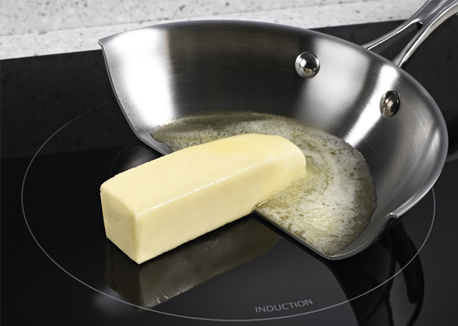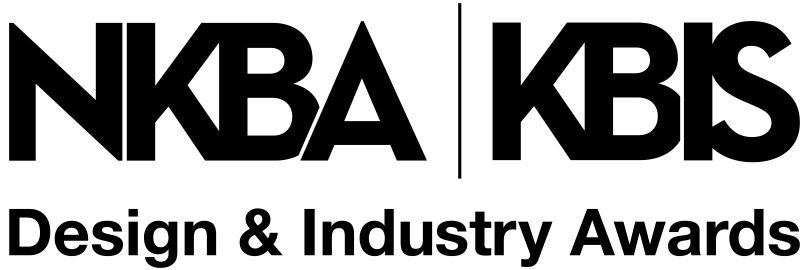As one of the newer kitchen options in Universal and sustainable design, induction cooktops are gaining popularity in the design community. According to the 2011 National Kitchen & Bath Association (NKBA) Kitchen and Bath Design Trend survey, 34 of the 100 members surveyed had specified induction cooktops in the final three months of 2010, up 8 percent from last year’s survey. Among other things, induction cooktops are more energy-efficient than traditional electric cooktops, and their heating method allows for faster cooking.
In order to determine when it’s best to specify an induction cooktop for a prospective client, it is helpful for designers to have a deeper understanding of how induction cooking works and its advantages and disadvantages. We’ll begin with an in-depth look at the heat transference that makes induction cooking possible.
HOW IT WORKS
Induction cooking takes place when heat is generated directly in the cooking vessel, a pot or pan. Different from other cooking methods, the cooking vessel itself becomes the heat source, instead of the electrical coils or burning gas used in traditional conduction cooking. Induction cooking elements consist of a coil of copper wire placed beneath the cooktop’s ceramic glass surface. When the unit is turned on, an alternating electric current flows through the coil, producing a powerful, high-frequency oscillating electromagnetic field.
When a cooking vessel made of electromagnetic material, such as a cast-iron skillet or stainless-steel pot, is placed over the induction element, the magnetic field transfers, or induces, energy into the cooking vessel. The magnetic current causes the molecules of the metal cooking vessel to vibrate at high frequencies, creating friction, which in turn, heats the vessel. While the current is large, it is produced by a low voltage. By controlling the strength of the electromagnetic field, the cook controls the amount of heat being generated in the cooking vessel.
Since the heat is generated by an induced electric current, the cooktop can detect whether or not cookware is present on the surface by monitoring how much power is being absorbed. This allows the cook to maintain a minimal boil in a pot or an automatic shut-off function when cookware is removed from the element.
KNOW THE ADVANTAGES
Induction cooktops allow for a wide range of benefits that make life easier for the homeowner. These include:
• Faster cooking. Serious cooks will report the biggest advantage of induction is that it allows for more powerful, faster cooking than any other type of cooktop. Cooks can adjust heat instantly and more precisely. Before induction cooking came along, the vast majority of serious cooks, including professional chefs, preferred gas cooktops over all forms of electric cooktops because traditional electric cooktop elements are slow to heat and slow to decrease heat. With gas heat, cooks have always been able to adjust the energy flow instantly by adjusting the element setting. Induction cooking elements, however, have proven to be every bit as instantaneous and precise as gas and then some, therefore making them faster cooking than gas.
• No wasted heat. Induction cooktops make for a much cooler kitchen. Since there is no heat produced by the cooking surface with induction cooking, kitchen air will likely not get warmer during the cooking process. With gas or conventional electric cooktops, energy is first converted to heat and only then is it transferred to the cooking vessel. This results in a large amount of that heat being wasted as it raises the temperature of the kitchen. With induction, the cooking vessel and the food itself will radiate some heat into the cooking area, but this is minimal compared to the excess heat generated by gas and conventional electric cooktops.
• A cooler, safer surface. Induction is, by far, the safest cooking method. When the cooking heat is contained in the pot, there are no open flames, red-hot electric coils or other radiant elements to burn the chef or kitchen visitors during the cooking process. And the stovetop barely gets warm—never hot enough to burn. This means no more burnt fingers from touching the cooktop directly. Even at the maximum element setting, a person could place a hand flat on the element without danger of being burned. This makes induction cooktops an ideal Universal Design kitchen option, as it provides a safer cooking environment for sensory-challenged homeowners.
• Easy cleanability. Because the induction cooktop has a flat ceramic glass top, spills are easy to wipe clean. In addition, since the cooking surface stays cool, there will be no more stubborn baked-on spills.
• Energy efficiency. Direct-to-vessel heating makes induction cooktops very energy-efficient. The U.S. Department of Energy has established that the typical efficiency of induction cooktops is 84 percent, as opposed to 40 percent with gas cooktops and 60 percent with conventional electric cooktops. With that kind of energy efficiency, induction cooktops are an excellent choice for projects that emphasize sustainability.
CONSIDER THE DISADVANTAGES
Now, let’s examine potential disadvantages of induction cooktops for some homeowners.
• Cooking vessel specifics. The fact that induction cooking only works with pots and pans made from magnetic materials is the most obvious drawback of induction cooking. Induction cooktops work most effectively with cast-iron and stainless-steel cookware, so homeowners whose kitchens are currently stocked with expensive aluminum, copper, glass or Pyrex cookware will need to invest in some new pots and pans. Technology that will eventually allow all metal cookware to be used on induction cooktops is in the works, so there may not be a cooking vessel compliance problem for much longer.
• Air circulation clearance. Induction cooktops require air circulation clearance below the cooking surface, which means they can’t be placed directly above an oven, nor can a drawer be installed below them.
• Limited color options. Induction cooktops are limited to ceramic glass surfaces, which are typically available only in black or white.
• Purchase costs. The cost of an induction cooktop is higher than that of the average gas or electric range. Induction cooktops start at around $1,500, versus $1,000 for a traditional cooktop. Therefore, it’s important for the client to understand that cooktops are a long-term investment, and the utility costs saved through the higher energy efficiency of induction cooktops could help recover the extra investment.
For those homeowners looking for sustainability, faster cooking time and a safer cooking environment, induction cooktops very well may be the ideal choice. It will be exciting to see how they are accepted in the market.
—Terri Connett is senior manager of contract marketing and design at Whirlpool Corp.









